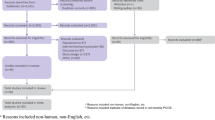Abstract
Purpose
The aim of this systematic review was to compare relevant health economic consequences of the CT-based robotic-arm-assisted system versus conventional Uni-compartmental Knee Arthroplasty (UKA).
Methods
In November 2020, A PRISMA systematic review was conducted using four databases (Pubmed, Scopus, Cochrane and Google Scholar) to identify all comparative studies reporting health economic assessments, such as robotic system costs, consumable costs, surgical revision rate, operating time, length of stay, and inpatient care costs.
Results
A total of nine comparative studies published between 2014 and 2020 were included in this systematic review. There was a moderate risk of bias as assessed using the ROBINS-I Tool. The CT-based robotic-arm-assisted system seemed to be associated with a lower risk of revision, decreased analgesia requirements during hospitalization, a shorter length of stay, and lower inpatient care costs compared to a conventional technique.
Conclusion
CT-based robotic-arm-assisted system for UKA appears to be an economically viable solution with a positive health economic impact as it tends to decrease revision rate compared to conventional UKA, improve post-operative rehabilitation and analgesia management. Post-operative inpatient care costs seem lower with the robotic-assisted system but depend on institutional case volume and differ among health systems. More studies are needed to confirm cost-effectiveness of CT-based robotic-arm-assisted system based on different health systems.
Level of evidence
Systematic review, Level IV


Similar content being viewed by others
References
Ode Q, Gaillard R, Batailler C et al (2018) Fewer complications after UKA than TKA in patients over 85 years of age: a case-control study. Orthop Traumatol Surg Res 104:955–959
Fabre-Aubrespy M, Ollivier M, Pesenti S et al (2016) Unicompartmental knee arthroplasty in patients older than 75 results in better clinical outcomes and similar survivorship compared to total knee arthroplasty. A matched controlled study. J Arthroplasty 31:2668–2671
Niinimäki T, Eskelinen A, Mäkelä K et al (2014) Unicompartmental knee arthroplasty survivorship is lower than TKA survivorship: a 27-year Finnish registry study. Clin Orthop Relat Res 472:1496–1501
Dyrhovden GS, Lygre SHL, Badawy M et al (2017) Have the causes of revision for total and unicompartmental knee arthroplasties changed during the past two decades? Clin Orthop Relat Res 475:1874–1886
Hernigou P, Deschamps G (2004) Alignment influences wear in the knee after medial unicompartmental arthroplasty. Clin Orthop Relat Res 423:161–165
Roche M (2014) Robotic-assisted unicompartmental knee arthroplasty: the MAKO experience. Clin Sports Med 33:123–132
Plate JF, Mofidi A, Mannava S et al (2013) Achieving accurate ligament balancing using robotic-assisted unicompartmental knee arthroplasty. Adv Orthop 2013:837167
Cobb J, Henckel J, Gomes P et al (2006) Hands-on robotic unicompartmental knee replacement: a prospective, randomised controlled study of the acrobot system. J Bone Joint Surg Br 88:188–197
Batailler C, White N, Ranaldi FM et al (2019) Improved implant position and lower revision rate with robotic-assisted unicompartmental knee arthroplasty. Knee Surg Sports Traumatol Arthrosc 27:1232–1240
Dretakis K, Igoumenou VG (2019) Outcomes of robotic-arm-assisted medial unicompartmental knee arthroplasty: minimum 3-year follow-up. Eur J Orthop Surg Traumatol Orthop Traumatol 29:1305–1311
Kleeblad LJ, Borus TA, Coon TM et al (2018) Midterm survivorship and patient satisfaction of robotic-arm-assisted medial unicompartmental knee arthroplasty: a multicenter study. J Arthroplasty 33:1719–1726
Liberati A, Altman DG, Tetzlaff J et al (2009) The PRISMA statement for reporting systematic reviews and meta-analyses of studies that evaluate healthcare interventions: explanation and elaboration. BMJ 339:b2700
Sterne JA, Hernán MA, Reeves BC et al (2016) ROBINS-I: a tool for assessing risk of bias in non-randomised studies of interventions. BMJ 355:i4919
Jakobsen RB, Engebretsen L, Slauterbeck JR (2005) An analysis of the quality of cartilage repair studies. J Bone Joint Surg Am 87:2232–2239
Blyth MJG, Anthony I, Rowe P et al (2017) Robotic arm-assisted versus conventional unicompartmental knee arthroplasty: Exploratory secondary analysis of a randomised controlled trial. Bone Joint Res 6:631–639
Cool CL, Needham KA, Khlopas A, Mont MA (2019) Revision analysis of robotic arm-assisted and manual unicompartmental knee arthroplasty. J Arthroplasty 34:926–931
Gilmour A, MacLean AD, Rowe PJ et al (2018) Robotic-arm-assisted vs conventional unicompartmental knee arthroplasty. The 2-year clinical outcomes of a randomized controlled trial. J Arthroplasty 33:S109–S115
Hansen DC, Kusuma SK, Palmer RM, Harris KB (2014) Robotic guidance does not improve component position or short-term outcome in medial unicompartmental knee arthroplasty. J Arthroplasty 29:1784–1789
Kayani B, Konan S, Tahmassebi J et al (2019) An assessment of early functional rehabilitation and hospital discharge in conventional versus robotic-arm assisted unicompartmental knee arthroplasty: a prospective cohort study. Bone Joint J 101B:24–33
MacCallum KP, Danoff JR, Geller JA (2016) Tibial baseplate positioning in robotic-assisted and conventional unicompartmental knee arthroplasty. Eur J Orthop Surg Traumatol 26:93–98
St Mart J-P, de Steiger RN, Cuthbert A, Donnelly W (2020) The three-year survivorship of robotically assisted versus non-robotically assisted unicompartmental knee arthroplasty. Bone Joint J 102B:319–328
Vakharia RM, Sodhi N, Cohen-Levy WB et al (2019) Comparison of patient demographics and utilization trends of robotic-assisted and non-robotic-assisted unicompartmental knee arthroplasty. J Knee Surg 34(06):621–627
Wong J, Murtaugh T, Lakra A et al (2019) Robotic-assisted unicompartmental knee replacement offers no early advantage over conventional unicompartmental knee replacement. Knee Surg Sports Traumatol Arthrosc 27:2303–2308
Pearle AD, van der List JP, Lee L et al (2017) Survivorship and patient satisfaction of robotic-assisted medial unicompartmental knee arthroplasty at a minimum two-year follow-up. Knee 24:419–428
Chawla H, van der List JP, Christ AB et al (2017) Annual revision rates of partial versus total knee arthroplasty: A comparative meta-analysis. Knee 24:179–190
Klasan A, Carter M, Holland S, Young SW (2020) Low femoral component prominence negatively influences early revision rate in robotic unicompartmental knee arthroplasty. Knee Surg Sports Traumatol Arthrosc 28:3906–3911
Batailler C, Bordes M, Lording T et al (2021) Improved sizing with image-based robotic-assisted system compared to image-free and conventional techniques in medial unicompartmental knee arthroplasty. Bone Joint J 103B:610–618
Pugely AJ, Martin CT, Gao Y et al (2015) The incidence of and risk factors for 30-day surgical site infections following primary and revision total joint arthroplasty. J Arthroplasty 30:47–50
Bhandari M, Smith J, Miller LE, Block JE (2012) Clinical and economic burden of revision knee arthroplasty. Clin Med Insights Arthritis Musculoskelet Disord 5:89–94
Robertsson O, Knutson K, Lewold S, Lidgren L (2001) The Swedish Knee Arthroplasty Register 1975–1997: an update with special emphasis on 41,223 knees operated on in 1988–1997. Acta Orthop Scand 72:503–513
Siebert W, Mai S, Kober R, Heeckt PF (2002) Technique and first clinical results of robot-assisted total knee replacement. Knee 9:173–180
Nimmo SM, Foo ITH, Paterson HM (2017) Enhanced recovery after surgery: pain management. J Surg Oncol 116:583–591
Clement ND, Bell A, Simpson P et al (2020) Robotic-assisted unicompartmental knee arthroplasty has a greater early functional outcome when compared to manual total knee arthroplasty for isolated medial compartment arthritis. Bone Joint Res 9:15–22
Abdelfadeel W, Houston N, Star A et al (2020) CT planning studies for robotic total knee arthroplasty: what does it cost and does it require a formal radiologist reporting? Bone Joint J 102B:79–84
Clement ND, Deehan DJ, Patton JT (2019) Robot-assisted unicompartmental knee arthroplasty for patients with isolated medial compartment osteoarthritis is cost-effective: a markov decision analysis. Bone Joint J 101B:1063–1070
Moschetti WE, Konopka JF, Rubash HE, Genuario JW (2016) Can robot-assisted unicompartmental knee arthroplasty be cost-effective? A Markov decision analysis. J Arthroplasty 31:759–765
Mahomed NN, Barrett J, Katz JN et al (2005) Epidemiology of total knee replacement in the United States medicare population. J Bone Joint Surg-Am 87:1222–1228
Conditt MA, Conditt M, Coon T, Roche M et al (2013) Two year survivorship of robotically guided unicompartmental knee arthroplasty. Bone Joint J Orthop Proc 95B(Suppl. 34):294
Author information
Authors and Affiliations
Contributions
FBV, KK, ESM, TL and CB contributed to collect data and write the manuscript. ES and SL provided overall supervision of conducting this review. All authors reviewed and validated the final version of the manuscript.
Corresponding author
Ethics declarations
Conflict of interest
S.L. is a consultant for Smith & Nephew, Stryker, Groupe Lepine, Medacta, receives institutional research support from Corin and Amplitude and is a board member for KSSTA, Maitrise Orthopédique and JBJS Am. The other authors declare that they have no conflicts of interest.
Additional information
Publisher's Note
Springer Nature remains neutral with regard to jurisdictional claims in published maps and institutional affiliations.
Rights and permissions
About this article
Cite this article
Bernard-de-Villeneuve, F., Kayikci, K., Sappey-Marinier, E. et al. Health economic value of CT scan based robotic assisted UKA: a systematic review of comparative studies. Arch Orthop Trauma Surg 141, 2129–2138 (2021). https://doi.org/10.1007/s00402-021-04066-w
Received:
Accepted:
Published:
Issue Date:
DOI: https://doi.org/10.1007/s00402-021-04066-w




